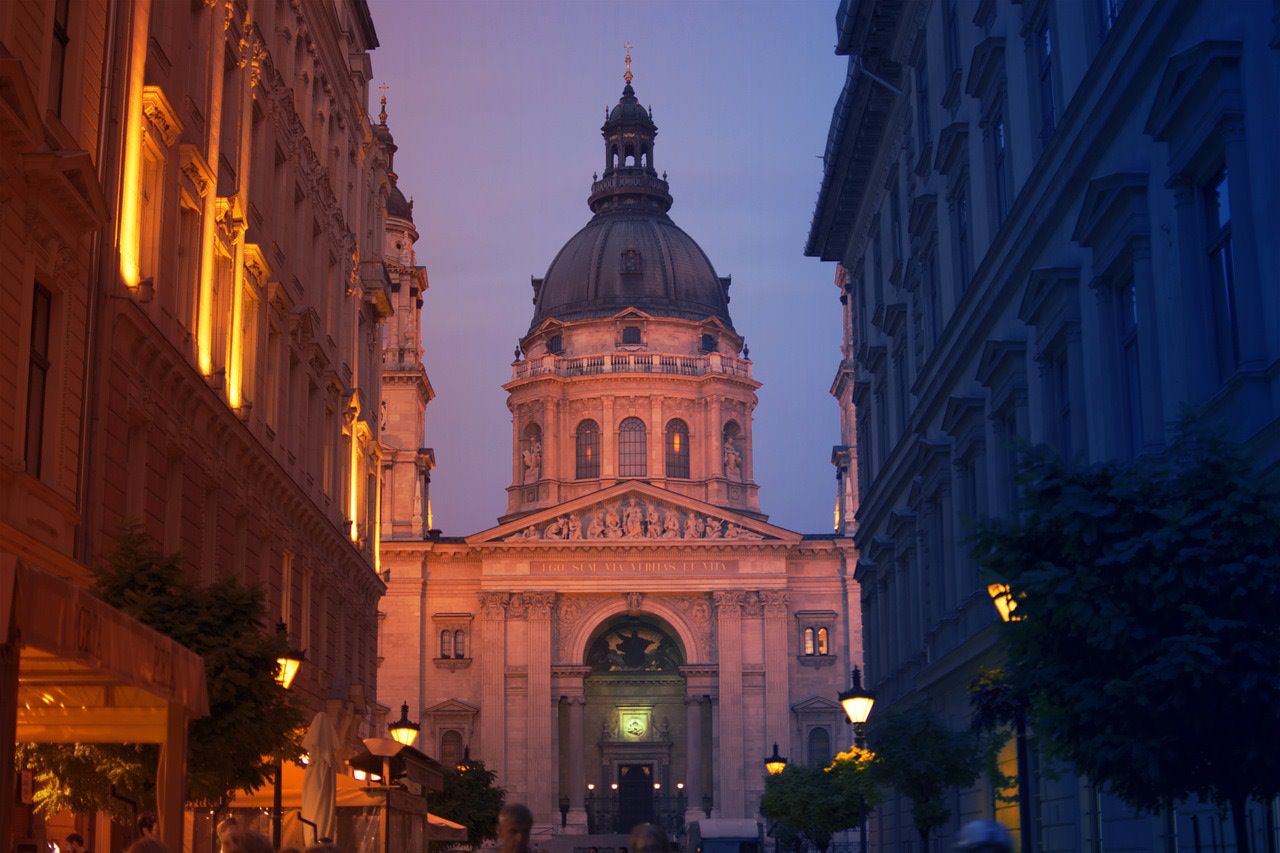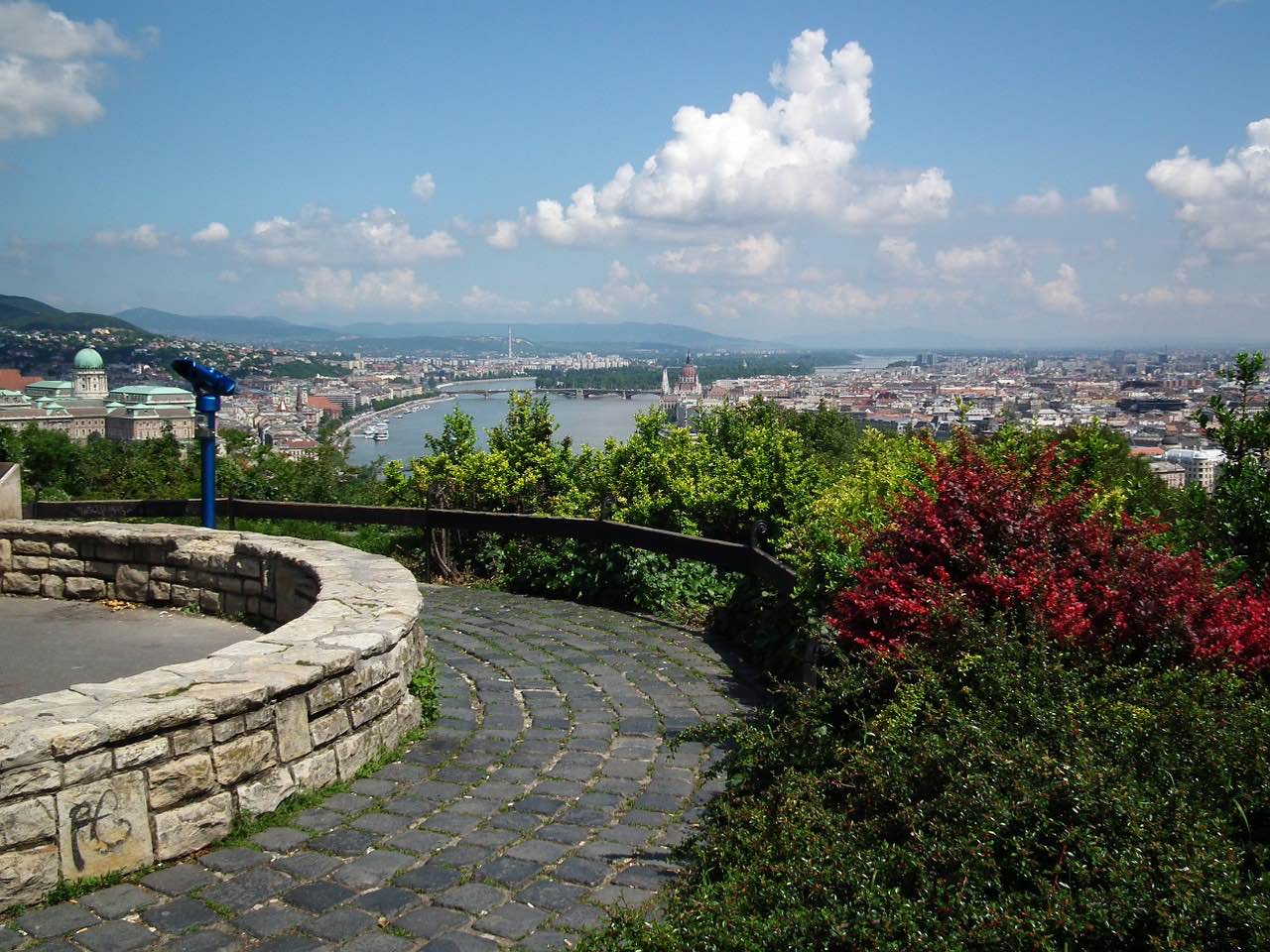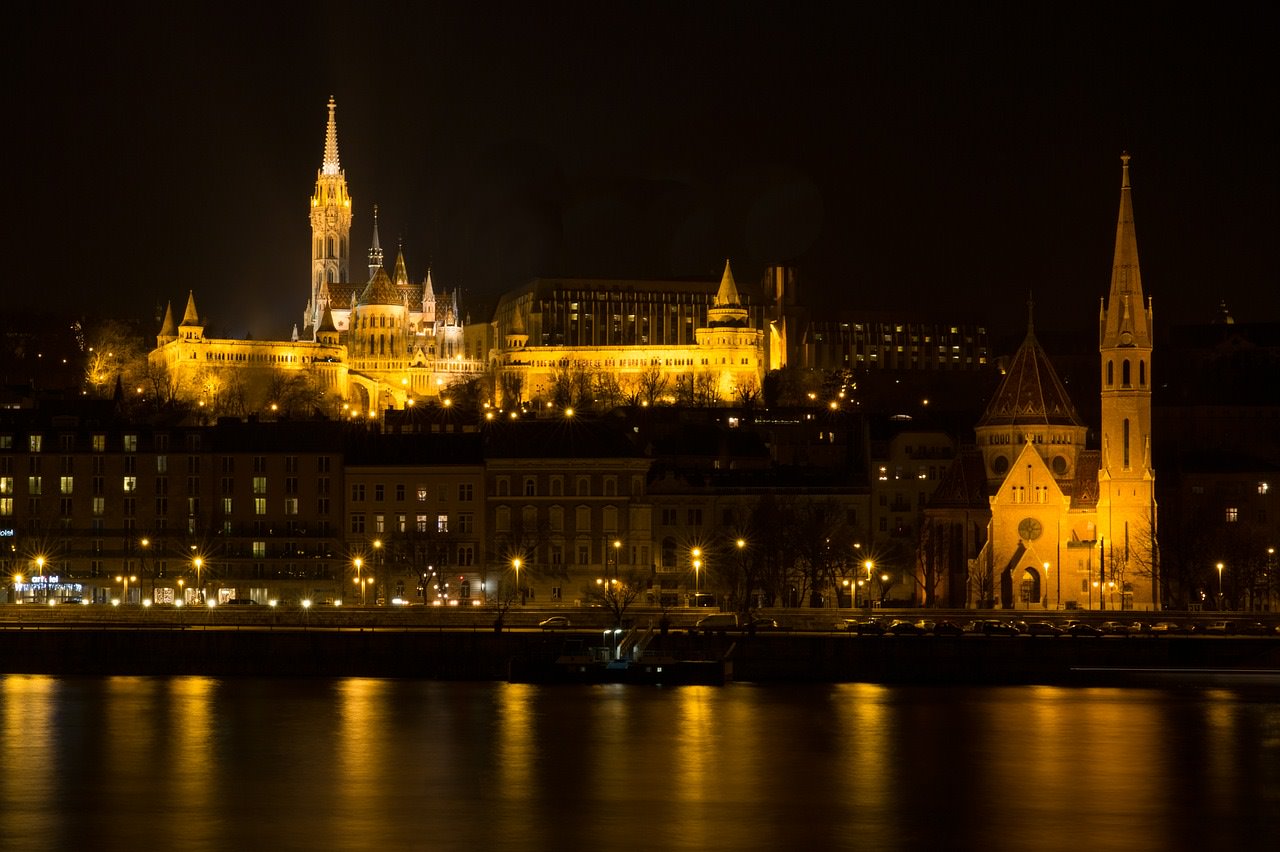The capital of Hungary is rightly considered the pearl of the Danube with an artistic and cultural heritage of enormous respect. Here are some of the most iconic and interesting places not to be missed during a weekend in Budapest
WHAT TO SEE IN A WEEKEND IN BUDAPEST
We start from the splendid bridge, 202 meters long and decorated at the entrance with lion statues, while cars circulate under the two neoclassical arches. Walking along the next Roosevelt Tér, you can admire the fortress from the Buda hill on the opposite side: truly splendid. This is one of the busiest squares in Budapest, as well as the area of some large hotels.
In the next Vorosmarty Tér, you can not miss a visit to Gerbeaud, the elegant coffee and pastry shop founded in the distant 1858 by the Swiss homonym: an authentic institution in the city. Just opposite, there is the ancient underground station, the first in Europe!
SAINT STEPHEN CHURCH
The beautiful Szent István Bazilika, just a few minutes away from here, a true neo-Renaissance style masterpiece by Jószef Hild and Miklós Ybl. There Basilica of St. Stephen it is certainly one of the symbols of Pest; presents a Greek cross plan, and its great collapsed dome is rebuilt for 2 times. Note that the highest point of the building is placed at 96metri, like the Parliament Building; it is the symbol of the presence in equal parts in the State, of religion and politics. In Pest, no building can be taller than 96m! The interior is decorated with rich Hungarian marbles, mosaics and fine works of art by the leading Magyars. Behind the high altar, inside a chapel, is the mummified right hand of the venerated Saint Stephen.
In the entrance hall is the Treasure, which displays sacred silver from the 19th and 20th centuries. The view from the top of the Belvedere Tower is splendid, and we recommend climbing it. Every Monday, at 17:00, there is an evocative organ concert.
The Basilica is open every day, from Monday to Saturday from 09:00 to 17:45 and on Sunday from 13:00 to 17:45.
The entrance ticket for the Basilica alone costs 2,400 forints. The ticket for visiting the Basilica, the Chapel of the Right Hand, the Treasury and the Belvedere Tower, however, costs 4,500Ft.. More information on the official website from this link.
LIBERTY SQUARE
A little further, Szabadság tér, is a beautiful square built in 1886 in the place where Lajos Batthyány, president of the first Hungarian government, was executed on 6 1849 October. Today, it houses the US Embassy and the Bank of Hungary as well as many Art Nouveau buildings; and, moreover, the Soviet War Memorial, a monument dedicated to the Soviet soldiers of the 1945, in memory of the red beloved. Not to be missed during the Budapest Weekend, the touching Shoes on the Danube; 60 pairs of abandoned shoes and boots on the bank of the river are reproduced; the work commemorates the Jews shot and thrown into the river in the 44 by pro-Nazi militiamen!
Kossuth Lajos Tér, is the vast square that gives the homonymous building, symbol of Pest, or the Parliament. The square is really huge, embellished by beautiful gardens, statues and palaces. Here, you find the interesting Ethnographic Museum, dedicated to Hungarian traditions and folklore. The museum houses a permanent exhibition on Magyar culture and the evolution of civilization.
PARLIAMENT
In the Square, stands majestic the Parliament building; it’s a huge neo-Gothic building raised in the 1884 on the banks of the Danube. Do not go unnoticed its splendid neo-gothic forms with pinnacles, windows and the high dome (which, we remember, has the same height as the Basilica). The realization of this enormous building was called the most important artists of the whole nation; tapestries, frescoes, and paintings, here contained, are the work of 19th century Hungarian artists.
Today, in its halls, the Presidential Council of the Republic, the Council of the Government and, above all, a part of the Saint Stephen’s Treasure (the other, however, is located in the National Museum) with the globe, the scepter and the wonderful crown not to be missed. Open every day, from Monday to Sunday, from November to March from 08:00 to 16:00 and from April to October from 08:00 to 18:00. The full ticket, for European citizens, is 6500HUF (16.23€), while for children from 6 to 24 years old, it is 3250HUF (8€). A special family ticket is also available for up to 2 adults and 2 children at 13650HUF (about 23€). It should be noted that non-European citizens pay a whopping 13000HUF. More info available from this link.
WHAT TO SEE IN A WEEKEND IN BUDAPEST: MARGARET ISLAND
About 800 meters of walking and you reach the Margaret Bridge, from which begins the homonymous Margaret Island, immense green city lung. Margit-híd, is the second bridge in Budapest, built in the distant 1876; the works were commissioned and completed by the same company that took care of the construction of the Eiffel Tower in Paris. Bombed in the 1944, after 600 lost their civilian lives and 40 German soldiers, it was quickly rebuilt by reusing several original pieces recovered from the Danube.
From the bridge you have access to the beautiful Margaret Island, a veritable huge park with a length of 2500m and a width of 500m; an oasis of peace and relaxation, forbidden to vehicles (except for trams and some buses) in which to run, walk and spend a few hours in full and total relaxation. There are zoos, swimming pools, spas, museums, churches and it is also possible to rent bicycles to visit it entirely.
At 21:00 o’clock, do not miss to stop at the beautiful Margitszigeti szökőkút, marvelous fountain, whose water jets, right at the stroke of the fateful hour, move to the rhythm of classical music. For more info, please consult our special FROM THIS LINK.
Seeing the whole island is really challenging from the point of view of time, and, you know, that in a single weekend the time … .. is money! It could be nice to spend a full half day here, weather permitting. Alternatively, you could watch the magic fountain show, and postpone the visit to one of the present days.
In addition to lots of nature, relaxation and fun, on the island there are quite a few things to see; the Centennial Memorial of the 1973, which commemorated the centenary anniversary of the unification of the city; a small and beautiful Japanese garden; a zoo, containing a large variety of exotic ducks; the “Musical Wheel” (Zenélő kút), that is, a small pavilion, originally built for concerts, located near the bridge Árpád; an octagonal tower water tank, built in Art Nouveau style in the 1911, with the Music Fountain, protected by UNESCO. And, furthermore, tennis courts, an athletic center, the largest outdoor swimming complex in Budapest (Palatine Water Park) and the Swimming Stadium!
WEEKEND IN BUDAPEST: BUDA
It is the day dedicated to the visit of Buda, which is no less than Pest, has so much to offer the eye of visitors: so, get ready. The advice is to get up early, and do not worry: sleep lost you can recover it back from vacation.
Reach the Margaret Bridge and, if you have not done the previous day, take a walk in the green of the island, tasting some local sweet perhaps accompanied by a fresh lemonade, which, in these parts, is rather popular. From Margit Hid, we invite you to take a tour of the city; not the usual tourist buses, because here in Budapest there are trams, cheap (cost of a simple ride) is really impressive.
Take the 19 number, in the direction Kelenföld Vasútállomás, destination Gellért-hegy, the hill overlooking the Danube, south of the fortress. At the foot of the hill, there are two spas: the Rác Fürdo, which is the oldest bath in Buda, and the Rudas Fürdo. Beautiful, however, the Hotel Gellért, a renowned building at the foot of the Liberty Bridge. It is a beautiful building of the early ‘900 that houses the baths of the same name.
THE CITADEL
You walk through a series of stairs and a long and tiring climb that leads, then, to the esplanade of the Citadel. Alternatively, the 27 bus takes you nearby. The monument that precedes the latter is beautiful: the Szabadság Szobor, first dedicated to the Soviet soldiers who fell in the Second World War and, subsequently, to all those who lost their lives in Hungary for freedom and democracy. The Gellért Hill, where the Citadel stands out, is one of the highest points of the city: for this reason, from here, you can enjoy a unique view and panorama of the whole city. Beautiful and really impressive, especially at night, all lit.
The Citadel was built by the Austrians in the 1851 as a place of defense of the Habsburg monarchy; it is long 220 meters, with high walls up to 16. Along the esplanade, there are still some old artillery pieces, accompanied by panels that illustrate the whole history of the place. You can not miss the souvenir shops on the way. Inside, in addition, in an old German bunker, a special Wax Museum was set up (1944 Panoptikum), which evokes the history of the Nazi occupation in the ’44 through photos and reconstructions.
BELVAROS
Going down the hill, cross the Elisabetta Bridge, one of the most modern in the city, but no less characteristic. Once you reach the other side, you can reach the 2 tram Vásárcsarnok, the Central Market. Inside, this market is certainly the most famous, ancient and busy of the whole city. It was built in the late nineteenth century, deeply damaged during the period of the wars, is reported in the years’ 90 to its former glory. A really huge and well-kept building, inside which, among the various stands, you can find a little of everything. On the ground floor mostly food, fruit and vegetables, spices, meat of all kinds, sweets and alcohol. Upstairs various objects, souvenirs with magnets, cups and fabrics. Open every day except Sundays and holidays, with the following hours: Monday, from 06:00 to 17:00; Tuesday to Friday, from 06:00 to 18:00; Saturday from 06:00 to 14:00.
A very short distance away, Vaci Utca, is the shopping street of Budapest; it is one of the main pedestrian arteries and, perhaps, the most famous street in the center of Budapest with many restaurants, shops and boutiques for shopping. If you have not found anything at the Market, we recommend stopping in this area to have lunch.
BUDA CASTLE
By a means, you reach the Chain Bridge, beyond which you can take the suggestive Sikló, or a funicular built in the 1870 that will take you to the top of the hill Budai Vár, the Buda Castle.
The Buda Castle is one of those places that it is impossible not to visit during your Budapest Weekend. In the 1987, UNESCO declared the entire Castle District, a World Heritage Site! Beautiful and evocative, the medieval castle is one of the most visited places in the city. Historic home of the great Hungarian kings, it has been repeatedly remodeled over the years, keeping the charm intact. Inside is a succession of beautiful alleys and squares, palaces, museums, restaurants and of course, the inevitable souvenir shops. A wonderful and fascinating village that we recommend to travel slowly, as if time were suspended.
In the southern part of the hill, the outline of the Royal Palace, built in the thirteenth century. This imposing building dominates the city from the top of the Castle district and, inside, houses monuments and museums; offers a fantastic and suggestive view on the Danube and on Pest. It can be reached by passing the historical Porta di Corvino, with the black crow above it; alternatively, you can climb along the Hapsburg staircase, opposite the funicular’s arrival. The Palazzo del Leone Court is one of the most beautiful in Hungary; here are the fountain of Matthias, dominated by the imposing figure of King Matthias Corvinus in a hunting lodge, and the statue of the Buttero. The Royal Palace, built in the thirteenth century, houses the Széchenyi Library, il Museum of History of Budapest, and the Magyar Nemzeti Galéria, that is, the National Gallery Hungarian. Just the latter recommend the visit, since it is impossible to visit everything in one day.
The Hungarian National Gallery, was founded in 1957, and housed in the three main sectors of the Royal Palace of Buda in the 1975. About one hundred thousand objects are placed inside the four floors of the Galleria-museo; It is interesting because it offers a range of Hungarian art from the Middle Ages to today. Here, you will find a rich collection of 19th century paintings and sculptures, Renaissance and Baroque art; in addition, a section dedicated to the famous Hungarian painter Mihály Munkácsy and to the father of Hungarian Impressionism Pál Merse Szinyei. Finally, do not miss the precious altarpieces of the Great Hall of the Throne.
The museum is open every day except Mondays from 10:00 to 18:00. The ticket office closes one hour earlier and the exhibition halls are open until 17:30. The full ticket costs 5400HUF (approximately 13€). People aged between 6 and 26 and between 62 and 70 pay the reduced price (2700HUF). Free for children under 6 and seniors over 70. For all information and temporary exhibitions, we invite you to consult the official website from this link.
The Historical Museum of Budapest (Budapesti Történeti Múzeum) retraces the fundamental steps in the history of the city, from the unification of the 1873. Through the various restored rooms of the building, including the Gothic, Renaissance and the Chapel of the Tower, you can see findings that testify to the whole history of the city; in the south wing, some medieval rooms, a small prison and a chapel have been found. Nearby is the Széchenyi Library, or the National Library of Hungary. Founded in 1802 by the Hungarian patriot Count Ferenc Széchényi, who at the end of the 18th century collected an important collection of Hungarian books by buying them at home and abroad. Today, the library collects around 8 millions of pieces including books, maps, engravings, manuscripts, newspapers, and more. Furthermore, the first book printed in Hungary is kept here, Chronica Hungarorum printed and published in the 1473. Open Tuesday to Saturday from 09:00 to 19:00.
In the heart of the fortress, absolutely not to be missed Labyrinth of the Castle (Budavári Labirintus); it is a system of caves that winds up to 16 meters below the castle, for an extension of over a kilometer. Once used mainly for military reasons, such as prisons, places of torture or hiding places, today these caves can be visited; they host exhibitions and exhibitions, as well as wax statues of many famous Hungarian people. We strongly recommend the visit.
The facility is open daily from 09:30 to 19:30. From 20:30 to 08:00 in the morning it is possible to book a night visit, with entrance from the corner of Lovas utca and Palota út. The entrance ticket for an adult costs 5000HUF (12.50€); students, pensioners and teachers pay 4500HUF, while children from 6 to 12 pay 1000HUF. A special FAMILY TICKET is also available which at the cost of 10000HUF (25€) allows access to two adults and two children up to 12 years old. More info available on the official website directly from here.
ST. MATTHEW CHURCH
The Church Mátyás-templon, is the pride of Budapest as well as the most important sacred building in the whole city. Built in the 13th century in French Romanesque forms, it underwent several renovations over time. Do not miss the three naves and the tower, the decorations of the chapels and the carvings of the gates. To the right of the presbytery, descend to the crypt where the treasure is located, with shoe jewelery and a copy of the crown of Hungary. In Matthias Church Many Hungarian kings have been crowned, and today they regularly host concerts.
The Church rises in the splendid Szentháromság Tér, or Piazza della Santa Trinità, located in the center of the fortress; here, stands the baroque Colonna della Trinità, erected in 1713, and the Ministry of Finance, housed in a beautiful neo-Gothic palace. Mátyás-templon, it’s really a gem; he will delight you with the beauty of its exteriors and richly decorated interiors. It is open every day from 09 to 17 and payment of 3100HUF per adult is required to enter. More info, from this link.
In the weekend in Budapest, not to be missed, nearby, a trip to the ancient pastry shop Ruszwurm, which was once a frequent visitor to Princess Sissi. Today, it is still furnished with period furniture and has a wide selection, among which the excellent Gerbaud cake and the equally excellent Óriás Isler stand out. But the choice is really wide; the Sacher first of all, prepared with three layers of jam as they love in these parts; the Borhabos; the Palacinka which, apparently, seems to have been born in Budapest; Kürtőskalács, a typical Transylvanian dessert that has many fans in Budapest.
FISHERMEN’S BASTION
Fishermen’s Bastion, Halászbástya, adjacent to the Matthias Church, is the ideal place to admire the entire city of Budapest. The building, in neo-Gothic and neo-Romanesque style, has been rebuilt in place of an ancient fortress; the seven towers symbolize the seven Hungarian capitals. At the center of the Bastione Court is the equestrian statue of King Stephen I, founder of the Hungarian State. From the tower it is possible to take really suggestive panoramic photos. The building is always open, every day. Before 9am and after 7pm in winter and 9pm in summer, entry is FREE, otherwise you have to pay an entrance fee of 1500ft (3.74€) for adults and 750ft (1.88€) for children aged 6 to 14. Official site: http://www.fishermansbastion.com
Bécsi Kapu ter, or, Vienna’s Gate Square, represents the traditional entrance to the fortress and is located in the upper part of the Castle District; it was the square of the ancient market. The door, decorated with atlases, cherubs and coats of arms is the symbol of the Christian reconquest of Buda of 1686. The statue of a woman in the center of the square evokes Ferenc Kazinczy, a Hungarian linguist.
VARÓSLIGET
Városliget is a beautiful park in the Pest area, as well as the famous Budapest meeting place. With an extension of 120 hectares, it is considered one of the main places of leisure and relaxation in the capital; inside it houses numerous buildings, gardens, a lake and many attractions. If you happen to happen in winter, there is an enormous skating rink on an artificial lake: really beautiful! Skates can be rented below the information office. The cost of the track is around the 1500 / 2000HUF while the skates are roughly 800HUF to now. It is open every day from 10:00 to 13:00 and 15:00 to 21:00. On Sundays, it closes around 19:00. Within Varósliget, there is a subway stop Széchenyi fürdő; alternatively, you can go down to Hosok Tér.
The Botanical Garden and Zoo, was inaugurated in 1866, and expanded in the following years. It has a monumental oriental entrance with elephant statues, and the unmissable House of Birds by Karoly Koos, and the House of the Elephants of Zsolnay.
The Vajdahunyad Castle, surrounded by a pond, stands in the middle of the park. An imaginative complex of the 1896, built by Ignác Alpár who assembled 21 copies of parts of different buildings, in order to retrace the history of Hungarian architecture. The most conspicuous part of the building is the exact reproduction of the Hunedoara Castle in Transylvania. Inside, the Castle hosts the Mezogazdasági Múzeum, the largest Agriculture Museum in Europe; in 21 sale offers a wide panorama of breeding, fishing, agricultural mechanization and oenology. The castle courtyard is open at all hours, and admission is free. The Museum is open Tuesday to Friday from 10 to 16 (from October to March) and from 10 to 17 in the other months. Saturdays and Sundays are open from 10 to 17. Closed on Monday. Official site: www.vajdahunyadcastle.com
In Varósliget there are also the Municipal circus, a Transport Museum, the Art Gallery Műcsarnok, and, above all, the wonderful Museum of Fine Arts, or the Szépmuvészeti Múzeum. A splendid neoclassical building, with the forms of a Greek temple, was erected in the 1906 by Albert Schickedanz and Fülöp Herzog; it is considered one of the most prestigious collections of figurative art in Europe. On the ground floor are collected Greek and Roman antiquities, Egyptian antiquities, European sculpture of the nineteenth and twentieth centuries; on the first floor are the pictorial collections, and there is no lack of authentic masterpieces, which would be impossible to list all. Open Tuesday to Sunday, 10:00 to 18:00. Tickets cost 5800ft standard fare and 2900ft concessions.
SZÉCHENYI BATHS
Széchenyi baths are thermal baths located in an ancient 1881 complex. Because of the strong popularity, others joined before the First World War, making Széchenyi baths the largest spa in Europe. The complex was completed in 1913 and was named after Count István Széchenyi.
The facility is open every day from 07:00 to 22:00, except for the thermal baths which close at 20:00. The entrance ticket costs 11000ft (27.46€) from Monday to Thursday, 12500 (31.20€) from Friday to Sunday, and 13500 (33.70€) on holidays. There are also carnets of 15 and 50 entrances. Discount of about 20%, from Monday to Thursday, for entrances before 09:00. Massages, aroma therapy, and many other services, available on the official website from this link. Baths are not recommended for children under 14 years.
*All information is purely indicative and should not be considered official. Timetables and prices may be subject to change. We therefore invite you to consult the official website for all updates. All trademarks and names contained herein belong to their respective owners.












